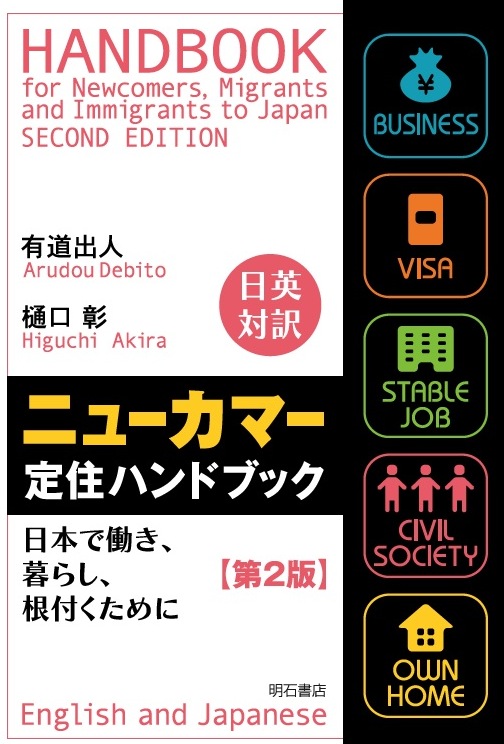mytest
Books, eBooks, and more from Debito Arudou, Ph.D. (click on icon):





![]()


UPDATES ON TWITTER: arudoudebito
DEBITO.ORG PODCASTS on iTunes, subscribe free
“LIKE” US on Facebook at http://www.facebook.com/debitoorg
https://www.facebook.com/embeddedrcsmJapan
http://www.facebook.com/handbookimmigrants
https://www.facebook.com/JapaneseOnlyTheBook
https://www.facebook.com/BookInAppropriate
If you like what you read and discuss on Debito.org, please consider helping us stop hackers and defray maintenance costs with a little donation via my webhoster:

All donations go towards website costs only. Thanks for your support!
Hi Blog. Welcome back from a Summer Break. I’m pleased to announce that I have a new monthly column at the progressive Shingetsu News Agency, the only place left (following the rightward editorial shift at The Japan Times) offering independent journalism on Japan in Japan.
Here’s an excerpt, where I stake out what the column space will be about:
////////////////////////////////////////////////////////
Visible Minorities: Debito’s New Column for the Shingetsu News Agency
SHINGETSU NEWS AGENCY, AUG 19, 2019 by DEBITO ARUDOU in COLUMNS
http://shingetsunewsagency.com/2019/08/19/visible-minorities-debitos-new-column-for-the-shingetsu-news-agency/
My name is Debito Arudou (or Arudou Debito, if you prefer), that guy from Sapporo who started writing about Japan from the early 1990s on a long-dead mailing list called the Dead Fukuzawa Society. I wrote so much there that I decided to archive my writings on a webpage. Debito.org soon blossomed into an award-winning reference site on life and human rights in Japan, and later a platform for newspaper articles and fieldwork research on racial discrimination.
After moonlighting at places like the now-defunct Asahi Evening News and Japan Today, I began writing in 2002 a column for Japan Times, first under Zeit Gist and then Just Be Cause.
Decades later, here we are with a new monthly column at the Shingetsu News Agency, under the title Visible Minorities.
I chose this title for two reasons.
The first is because my doctoral research, and most recent book, was on “visible minorities,” a term used by academics, and even the Canadian government, to discuss a more subtle form of discrimination. It is used when a minority is treated differently by a society, even if they formally have the same legal rights as fellow residents and citizens, because they don’t look physically the same as the majority group in that society.
In Japan, this term is especially useful because our hegemonic national narrative claims that Japan is monocultural, monoethnic, and homogeneous. In other words, Japan allegedly has no minorities. But, of course, it does: the Ainu, the Uchinanchu, the “Zainichi” ethnic Koreans and Chinese, the Burakumin, foreign residents, and naturalized citizens.
Naturally, academia and the Japanese government have habitually promoted the fiction that Japan has no racial discrimination because Japan has no “races.” After all, Japan’s minorities are supposedly indistinguishable from the Japanese majority.
In other words, since everyone allegedly “looks Japanese,” Japanese racism is somehow different—it’s not a matter of skin color, so therefore it’s not the real racism found in other countries.
But what about those foreigners and naturalized Japanese citizens like myself who do have a different skin color? They are ignored because they’re apparently too small a number to really count, or they’re here by choice and therefore somehow aren’t really part of Japan.
Nowadays, Non-Japanese residents make up about 2.1% of the total population of these islands, and the demographic trends reveal clearly, as the Japanese population ages and decreases, that this proportion will continue to rise in the decades ahead.
And yet, still overlooked are the people—including the Japanese born from the hundreds of thousands of international couples—who are sometimes refused entry to bathhouses, shops, restaurants, hotels, hospitals, schools, colleges, or other places offering licensed services to the public.
That’s why the term “visible minorities” matters. All you need to be treated unequally in many cases is to look foreign, and this is an issue that Japan needs to better grapple with at both the social and political level.
A second, related reason why I chose this term as the column’s title is because minorities in Japan, as noted above, have in fact been made invisible for quite some time.
This wasn’t always the case. Prewar Japan once prided itself on how ethnically diverse it was. Interbellum Japan had a sizable foreign-born population, and offered imperial citizenship to the peoples it colonized. Indeed, the Japanese government even claimed it was unique in colonizing peoples without the trappings of racial discrimination. Japan’s Pan-Asianism was better than the yoke of White Imperialism, they argued, because everyone being liberated was of the same Asian “race.”
Of course, a colonizer is still a colonizer, and minorities in Japan back then, as anywhere, not only endured exploitation, but also faced extra hurdles as Pan-Asians to “prove” themselves loyal subjects of Japan. This included conscription into the Japanese military and collaboration in the often brutal subjugation of their homelands.
When the Japanese Empire disappeared after the Pacific War, so allegedly did all the minorities in Japan. The subjects of empire were stripped of their Japanese citizenship and given marching orders to go back overseas. They could only remain in Japan with their investments if they took jobs on Japan’s economic peripheries (such as pachinko parlors or the criminal underworld), or if they registered as potentially subversive elements to the state (with criminal penalties for not carrying fingerprinted identification at all times). Putting them on a separate “foreign registry” system also enabled the government to exclude “foreigners” from Japan’s official population tallies—making them statistically invisible. The homogeneous Japanese ethnostate was a postwar invention.
But in this increasingly globalized world, Japan’s minorities need to become visible again. This column will highlight the underrepresented minorities, unpacking what keeps them disenfranchised from “mainstream” debate and dialog.
In the English-language news media, where foreign residents had a voice going back to the late 19th century, the trend has actually been in the direction of increased marginalization. Hardly ever do Non-Japanese get to create their own public image.
First you have the vanity-press English versions of the major newspapers: Asahi, Yomiuri, and Mainichi, which have long ago purged their ranks of actual foreign reporters doing original reporting.
Then there is the rightwing Fujisankei Communications Group, which bought up the foreigner-founded Japan Today and shifted its editorial bent away from foreign voices and toward Japan boosterism. That doesn’t even touch on the content of the unspeakable Japan Forward.
The once last-man-standing Japan Times has famously changed its tone under the new ownership that arrived in 2017, firing several of its major columnists who were critical of the government, and adopting officially-sanctioned terminology about historical events that adhere to an ahistorical line.
Other media run by minorities and Non-Japanese, including ethnic newspapers, newsletters, and websites, sadly have little reach and minimal impact on Japanese society.
Let’s try to change that. I look forward to writing for a Shingetsu News Agency that challenges the stale conventions and speaks truth to power. The point is to increase the visibility of minorities, and to assist Japanese of goodwill in dismantling the systems that keep them disenfranchised.
Thank you for reading me over the years. Let’s do some more good work.
ENDS
////////////////////////////////////////////////////////
Read the full text also at
http://shingetsunewsagency.com/2019/08/19/visible-minorities-debitos-new-column-for-the-shingetsu-news-agency/
Enjoy. Let’s hit the last three months of this year running, and help reverse the tide of xenophobia that has swept liberal democracies worldwide. Debito Arudou Ph.D.
======================
Do you like what you read on Debito.org? Want to help keep the archive active and support Debito.org’s activities? Please consider donating a little something. More details here. Or if you prefer something less complicated, just click on an advertisement below.
3 comments on ““Visible Minorities”: My first monthly column for the Shingetsu News Agency, Aug 19, 2019 (FULL TEXT)”
Four months dude. We still have four months left!
Good article – as usual Japan gets to shape its own story to suit its agenda. Most people worldwide, and at home, suck it up. It is worthwhile to point out the facts from time to time.
I’m pleased to read Debito’s first article at SNA!
I respect Shingetsu News Agency as I do Debito.
SNA is indeed critical and independent journalism.
Debito+SNA is a synergistic uniting we can support!
And yes, though this post is succinct, this is really me. 😉
Seriously: let’s fairly tip SNA’s patreon or Debito’s paypal. 🙂
Honest article authors deserve a few coins for their integrity.
— Thanks. But prioritize contributing to SNA more than Debito.org, of course. This is my hobby. SNA is Michael Penn’s living!
Hi Debito, it’s great that you are writing for the SNA and have escaped from the Japan Times! I have been reading your excellent articles for years and I am so glad you can now really express yourself freely on SNA. I look forward to many more years of your writings!